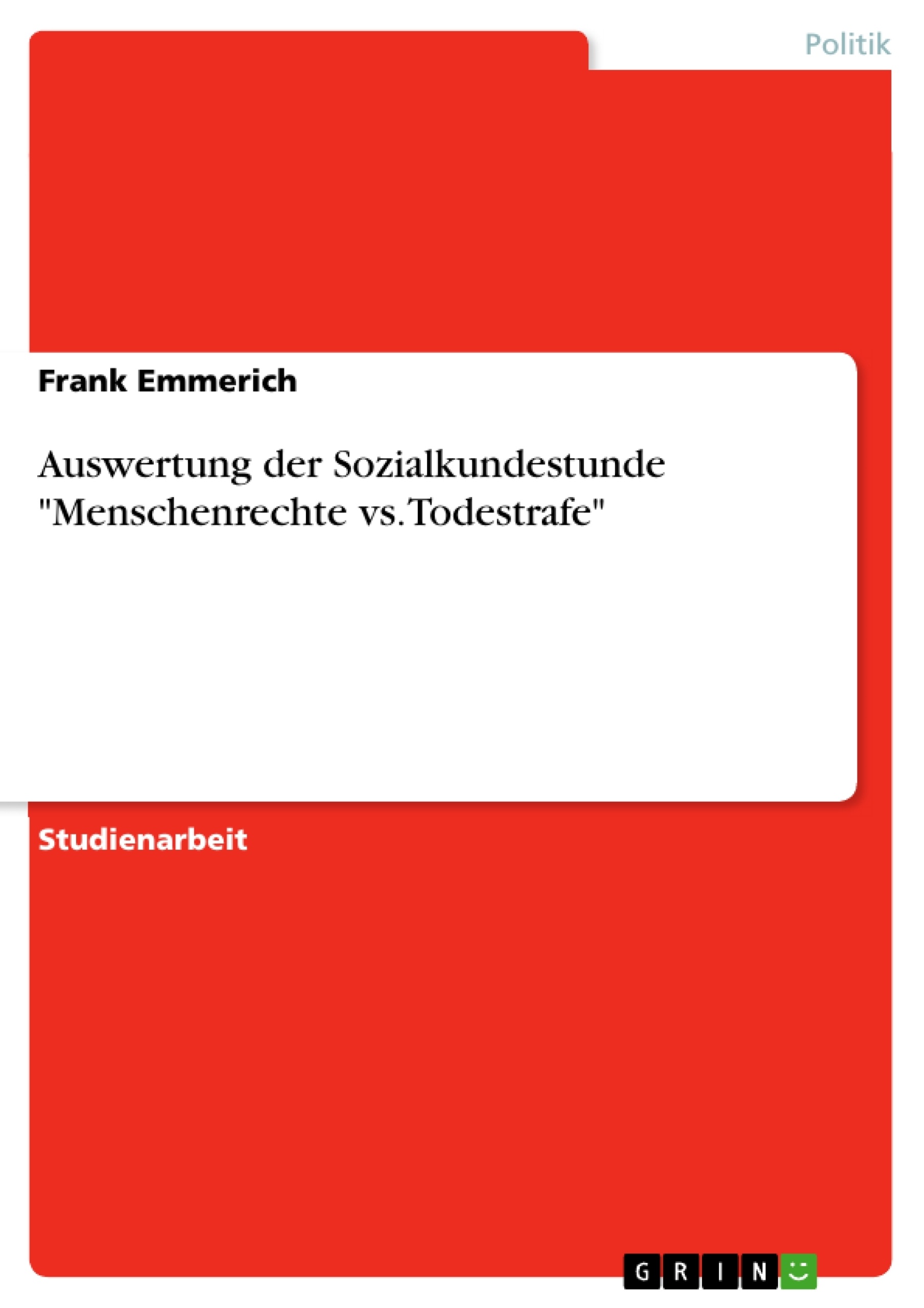Im Rahmen dieser schulpraktischen Übung war den Studenten das Thema „Menschenrechte“ der übergeordneten Unterrichtseinheit der zu gebenden Stunden vom Sozialkundelehrer benannt worden. Im Rahmenplan des Sozialkundeunterrichts von Mecklenburg-Vorpommern sind die Menschenrechte nicht als Themenbereich oder gar verpflichtender Unterrichtsgegenstand aufgeführt. Zur Planung der einzelnen Unterrichtsstunde ist es auch deshalb notwendig zu klären, inwieweit dieses Thema „trotzdem“ zur Erfüllung der angestrebten Ziele des Sozialkundeunterrichts der gymnasialen Oberstufe dienlich sein kann. Dabei ist der ursprüngliche dem Thema innewohnende Zweck natürlich nicht zu vernachlässigen. Im Gegenteil - diese beiden Aspekte sind die Grundsäulen der weiteren Planung der einzelnen Stunde.
So lassen sich verbindende Elemente der Unterrichtseinheit „Menschenrechte“ mit Themenschwerpunkten der Jahrgangsstufe 11 finden. Als Themenbereich wird im Rahmenplan zum einen „Staatsphilosophie/ Politische Theorie“ aufgeführt. Unter dem Thema „Staat, Herrschaft und Demokratie“ mit den Unterrichtsinhalten wie zum Beispiel „Der Gesellschaftsvertrag“ (Rousseau), „Vom Geist der Gesetze“ (Montesquieu) oder „Legitimatorische Grundlagen für Macht und Herrschaft“ lässt sich u. a. ein Bezug zur historischen Begründung von Menschenrechten ziehen. Ein weiterer Themenbereich dieser Jahrgangsstufe ist laut Rahmenplan „Das politische System der Bundesrepublik Deutschland“. Hier ist durch das obligatorische Thema „Grundrechte“ eine Schnittmenge mit dem Thema „Menschenrechte“ immanent. So sind die Menschenrechte durch das Grundgesetz in eine nationale Verfassung überführt bzw. eingebunden worden. Neben der offensichtlichen Schlussfolgerung, dass sich dieser Staat, also die Bundesrepublik Deutschland, seine demokratische Grundordnung auch auf Achtung der Menschenrechte aufbaut, ergibt sich auch eine weitere nicht außer Acht zu lassende Fragestellung der juristischen Einklagemöglichkeit von Menschenrechten in diesem Staat, aber eben auch weltweit. Daran anschließend und in direktem Bezug zu Historie der Menschenrechte steht die Frage nach der Funktion der Grundrechte sowie der Menschenrechte. Eng mit dem vorangegangenen verknüpft ist ein weiterer Aspekt , der kontrovers und somit auch problemorientiert diskutiert werden kann, nämlich die Frage nach dem homogenen oder heterogenen Auslegen von Menschenrechten in verschiedenen demokratischen Staaten.
Inhaltsverzeichnis
- Einleitende Überlegungen zur Auswahl der Thematik „Menschenrechte“ als Unterrichtseinheit
- Planung der Unterrichtsstunde „Todesstrafe versus Menschenrechte“
- Bedingungsanalyse
- Die Bedingungsanalyse zu „Schulpraktischen Übung“ in der 11. Klasse
- Die Rolle des Lehrenden in der Bedingungsanalyse
- Sachanalyse oder die Annäherung an den Gegenstandsbereich „ Menschenrechte“
- Sachanalyse zum Themenbereich „Menschenrechte“
- Sachanalyse zur konkreten Unterrichtsstunde
- Die didaktische Perspektive
- Ziele für die Unterrichtsstunde,,Menschenrechte versus Todesstrafe“
- Bedingungsanalyse
- Kritische Auseinandersetzung mit dem tatsächlichen Stundenverlauf
- Zusammenfassung
Zielsetzung und Themenschwerpunkte
Diese Hausarbeit befasst sich mit der Planung und Auswertung einer Unterrichtsstunde zum Thema "Todesstrafe versus Menschenrechte", die im Rahmen einer schulpraktischen Übung in einer 11. Klasse durchgeführt wurde. Die Arbeit analysiert die Relevanz des Themas "Menschenrechte" im Sozialkundeunterricht, untersucht die Bedingungsfaktoren für die Unterrichtsplanung und erörtert die sachlichen Inhalte der Unterrichtsstunde. Darüber hinaus werden die didaktischen Perspektiven und die Lernziele der Stunde definiert und die tatsächliche Durchführung der Stunde kritisch reflektiert.
- Die Bedeutung von Menschenrechten im Sozialkundeunterricht
- Die Planung einer Unterrichtsstunde zum Thema "Todesstrafe versus Menschenrechte"
- Die didaktische Perspektive und die Lernziele der Stunde
- Die kritische Reflexion der tatsächlichen Durchführung der Unterrichtsstunde
- Die Verbindung von Theorie und Praxis in der Gestaltung des Unterrichts
Zusammenfassung der Kapitel
- Kapitel 1 beleuchtet die Relevanz von "Menschenrechten" als Unterrichtseinheit im Sozialkundeunterricht und argumentiert, warum dieses Thema trotz fehlender expliziter Erwähnung im Rahmenplan des Sozialkundeunterrichts in Mecklenburg-Vorpommern relevant ist. Das Kapitel verweist auf die Verbindung von "Menschenrechten" mit anderen Themenbereichen des Sozialkundeunterrichts, insbesondere der "Staatsphilosophie" und dem "politischen System der Bundesrepublik Deutschland".
- Kapitel 2 befasst sich mit der Planung der Unterrichtsstunde "Todesstrafe versus Menschenrechte". Es analysiert die Bedingungen, die die Stunde beeinflussen können, wie z. B. die Schülergruppe, das Vorwissen der Schüler, der politische Kontext und die Rolle des Lehrenden. Die Sachanalyse fokussiert sich auf die Thematik "Menschenrechte" und die konkrete Unterrichtsstunde, in der die Todesstrafe als Beispiel für die Verletzung von Menschenrechten dient.
- Kapitel 3 präsentiert eine kritische Reflexion des tatsächlichen Stundenverlaufs. Es untersucht, inwieweit die geplanten Lernziele erreicht wurden und welche Herausforderungen und Chancen sich während der Durchführung der Stunde ergaben.
Schlüsselwörter
Die Hausarbeit widmet sich den Themen „Menschenrechte“, „Todesstrafe“, „Politische Bildung“, „Sozialkundeunterricht“, „Bedingungsanalyse“, „Sachanalyse“, „Didaktik“, „Lernziele“, „Unterrichtsplanung“ und „Stundenverlauf“. Sie untersucht die Relevanz von Menschenrechten im Kontext der politischen Bildung und die Möglichkeiten, dieses komplexe Thema in einer Unterrichtsstunde zu vermitteln.
- Quote paper
- Frank Emmerich (Author), 2006, Auswertung der Sozialkundestunde "Menschenrechte vs. Todestrafe", Munich, GRIN Verlag, https://www.grin.com/document/61837



